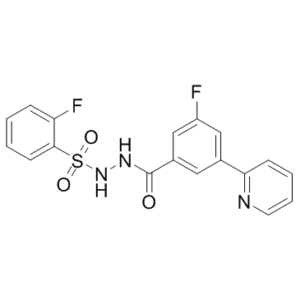WM-1119
This product is for research use only, not for human use. We do not sell to patients.

For small sizes, please check our retail website as below: www.invivochem.com
| Size | Price | Stock |
|---|---|---|
| 250mg | $850 | Check With Us |
| 500mg | $1450 | Check With Us |
| 1g | $2175 | Check With Us |
Cat #: V3686 CAS #: 2055397-28-7 Purity ≥ 98%
Description: WM-1119 (WM1119) is a novel, highly potent, and selective inhibitor of histone acetyltransferase KAT6A/B (lysine acetyltransferase) with potential anticancer activity.
Top Publications Citing Invivochem Products
Publications Citing InvivoChem Products
Product Promise

- Physicochemical and Storage Information
- Protocol
- Related Biological Data
- Stock Solution Preparation
- Quality Control Documentation
| Molecular Weight (MW) | 389.38 |
|---|---|
| Molecular Formula | C₁₈H₁₃F₂N₃O₃S |
| CAS No. | 2055397-28-7 |
| Storage | -20℃ for 3 years in powder formr |
| -80℃ for 2 years in solvent | |
| Solubility In Vitro | DMSO: ≥ 150 mg/mL (385 mM)r |
| Water: NAr | |
| Ethanol: NA | |
| SMILES Code | O=C(NNS(=O)(C1=CC=CC=C1F)=O)C2=CC(C3=NC=CC=C3)=CC(F)=C2 |
| Synonyms | WM1119; WM 1119; WM-1119 |
| Protocol | In Vitro | WM-1119 induces cell cycle exit and cellular senescence without causing DNA damage. WM-1119 is 1,100-fold and 250-fold more active against KAT6A than against KAT5 or KAT7, respectively, and so shows greater specificity for KAT6A than does WM-8014. Treatment of MEFs with WM-1119 results in cell cycle arrest in G1 and a senescence phenotype similar to that seen upon treatment with WM-8014. Notably, the activity of WM-1119 in this cell-based assay is an order of magnitude greater than WM-8014 and WM-1119 is able to induce cell cycle arrest at 1 μM. Treatment with WM-1119 inhibits the proliferation of the EMRK1184 lymphoma cells in vitro, WM-1119 (IC50=0.25 μM) is ninefold more active than WM-8014 (IC50=2.3 μM), as expected on the basis of reduced protein binding. |
|---|---|---|
| In Vivo | By day 14, the cohorts that are treated four times per day with WM-1119 have arrested tumour growth, with the exception of one mouse that does not respond. Spleen weights in the WM-1119-treatment group (treated four times per day) are substantially lower than spleen weights in the vehicle-treated group. Treatment with WM-1119 three times per day leads to a significant reduction in tumour burden and spleen weight, but is not as effective as treatment four times per day. WM-1119 is well-tolerated; mice show no generalized ill effects and weight loss is not observed. The proportion and overall number of tumour cells is substantially reduced by WM-1119 treatment (four times per day). |
These protocols are for reference only. InvivoChem does not
independently validate these methods.
| Solvent volume to be added | Mass (the weight of a compound) | |||
|---|---|---|---|---|
| Mother liquor concentration | 1mg | 5mg | 10mg | 20mg |
| 1mM | 2.5682 mL | 12.8409 mL | 25.6819 mL | 51.3637 mL |
| 5mM | 0.5136 mL | 2.5682 mL | 5.1364 mL | 10.2727 mL |
| 10mM | 0.2568 mL | 1.2841 mL | 2.5682 mL | 5.1364 mL |
| 20mM | 0.1284 mL | 0.6420 mL | 1.2841 mL | 2.5682 mL |
The molarity calculator equation
Mass(g) = Concentration(mol/L) × Volume(L) × Molecular Weight(g/mol)
Mass
=
Concentration
×
Volume
×
Molecular Weight*
The dilution calculator equation
Concentration(start)
×
Volume(start)
=
Concentration(final)
×
Volume(final)
This equation is commonly abbreviated as: C1 V1 = C2 V2
Concentration(start)
C1
×
Volume(start)
V1
=
Concentration(final)
C2
×
Volume(final)
V2
Step One: Enter information below
Dosage mg/kg
Average weight of animals g
Dosing volume per animal µL
Number of animals
Step Two: Enter the in vivo formulation
%DMSO
+
%
+
%Tween 80
+
%ddH2O
Calculation Results:
Working concentration:
mg/ml;
Method for preparing DMSO master liquid:
mg
drug pre-dissolved in
µL
DMSO(Master liquid concentration
mg/mL)
,Please contact us first if the concentration exceeds the DMSO solubility of the batch of drug.
Method for preparing in vivo formulation:
Take
µL
DMSO master liquid, next add
µL
PEG300, mix and clarify, next add
µL
Tween 80,mix and clarify, next add
µL
ddH2O,mix and clarify.
Note:
- (1) Please be sure that the solution is clear before the addition of next solvent. Dissolution methods like vortex, ultrasound or warming and heat may be used to aid dissolving.
- (2) Be sure to add the solvent(s) in order.




































